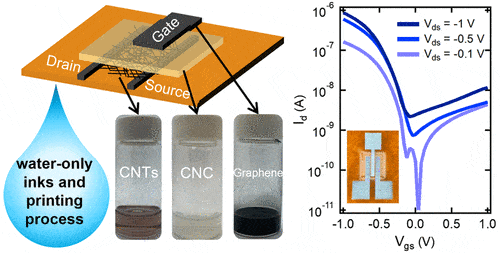A first-of-its-kind pioneering demonstration points to the possibility of a "greener" future for the electronic components sector

[Translation by Dr. Moshe Nachmani]
Engineers from Duke University have succeeded in producing the world's first ever fully recyclable printed electronic components. Their innovative solution replaces the use of toxic substances found in water as part of industrial production processes, thus reducing the impact on the environment and the possible health risks arising from the use of these dangerous substances. This initial demonstration opens a window for an industry that can reduce the ecological and health footprint. The study has long been published in the scientific journal Nano Letters.
One of the biggest challenges facing manufacturers of electronic components is the successful coating of several layers on top of components, one layer above the other, a coating that is essential in the production of advanced devices. This task can be a challenging task, especially for printed electronics, where proper adhesion of the layers is often a source of great frustration.
"If you make a sandwich of peanut butter and jam, one slice of bread on top of the other, the task is easy," said Aaron Franklin, a professor of electronic and computer engineering at Duke University, the lead researcher of the current study. "But if you put a layer of jam first on the slice of bread and try to spread the peanut butter on top of it, you really won't succeed - the layers won't stay one on top of the other, but will get mixed up between them. Placing layers one on top of the other is not the same as simply placing them on their own - however, this is what is required when you want to produce electronic devices through printing."
In a previous study by the same scientist, the research team demonstrated the world's first printed electronic components that were fully recyclable. These devices use three types of carbon-based ink: semiconducting carbon nanotubes, an electrically conductive graphene layer, and an insulating nanocellular layer. In trying to adapt this method to one that would use only water, the carbon nanotubes posed the biggest challenge of all. An inkjet printer places layers of carbon-based ink one on top of the other, in order to create transistor-type electronic components that can be fully recycled using water, instead of using toxic materials.

In order to create a water-based ink in which the carbon nanotubes do not stick to each other and indeed spread uniformly over the surface, the researchers add a surfactant similar to detergent. The resulting ink, on the other hand, does not ultimately create a layer of carbon nanotubes dense enough to allow a rapid and quantitative passage of electrons. "You want to get carbon nanotubes that look like "al dente" spaghetti placed on a flat surface," explains the lead researcher. "However, when using water-based ink, the tubes look like they were thrown against the wall to check if they were fully cooked. If we used chemicals, we could just print more and more layers until we got the nanotubes. However, an aqueous environment does not work like that - we can repeat this operation a hundred times and the compression will still remain the same as the first time." The reason for this lies in the fact that the surface active material used to prevent the nanotubes from sticking to each other also prevents additional layers from sticking to the first layer. As part of a normal production process, the surface-active substances can be removed using very high temperature, a process that requires a lot of energy, or using very toxic substances, which present health risks to humans or a risk to the environment. The research group wanted to avoid this.
As part of the new article, the researchers developed a cyclic process in which the device is dipped in water, dried at a relatively low temperature, and printed again, time after time, layer after layer. When also reducing the amount of surfactant used in the production of the ink, the researchers showed that the ink types and their processes give rise to water-based, functional and fully recyclable transistors. Compared to a resistor or capacitor, a transistor is a relatively complex computing component used in devices such as logic circuits and detectors. The researcher explains that, by demonstrating a transistor as a first demonstration, he hopes to signal to others involved in this field that there is a sustainable path to developing manufacturing processes for electronic components that are much more environmentally friendly.
The researcher has already proven in the past that close to one hundred percent of the carbon and graphene nanotubes used in printers can be recycled and reused in the same process, with little loss of the materials or the level of performance. Since nanocellulose is made from wood, it can be recycled or biodegraded like paper. And while the process does not utilize large amounts of water, the innovative process does not have high requirements for the use of toxic materials as is the case with normal production methods.
According to United Nations estimates, less than a quarter of the millions of kilograms of electronic components thrown into the trash each year end up being recycled. And this problem only gets worse as humanity progresses towards the use of sixth generation devices and as the field of Internet of Things (IoT) continues to expand.
Although more research is needed, the researchers say their approach could be used in the production of other electronic components such as screens and displays found in every home today.
